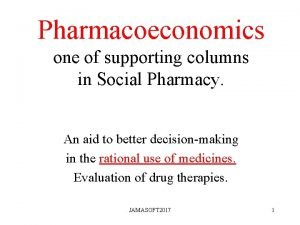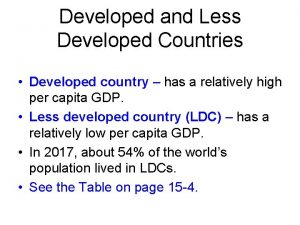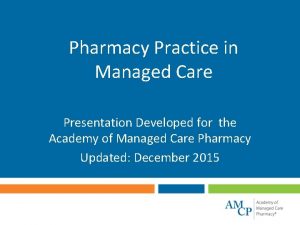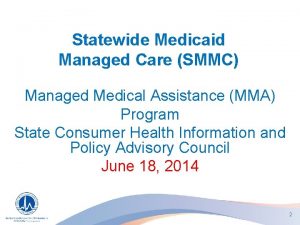Pharmacoeconomics Presentation Developed for the Academy of Managed




















- Slides: 20

Pharmacoeconomics Presentation Developed for the Academy of Managed Care Pharmacy Updated: February 2016

Objectives • Define the term pharmacoeconomics • Differentiate between the types of pharmacoeconomic evaluation methods • Discuss various considerations essential to evaluating a pharmacoeconomic design • Provide examples of how pharmacoeconomics is applied in practice and various roles for the pharmacist

Definition of Pharmacoeconomics • The process of identifying, measuring, and comparing the costs, risks, and benefits of programs, services, or therapies • To determine which alternative produces the best health outcome for the resource invested • Most impactful when making decisions about a population rather than individual • “Costs vs. Consequences of Alternatives”

Types of Economic Evaluation • • • Cost of illness evaluation (COI) Cost minimization analysis (CMA) Cost benefit analysis (CBA) Cost effectiveness analysis (CEA) Cost utility analysis (CUA)

Cost of Illness Evaluation • Also termed cost consequence model • Description: Estimates the cost of a disease within a defined population • Application: Provides a baseline for evaluating the impact of prevention/treatment options • Measurement Units: Monetary ($) • Example: Cost of peptic ulcer disease

Cost Minimization Analysis • Description: Identifies intervention cost differences between similar alternatives • Application: Identify least costly alternative when outcomes/consequences are identical • Measurement Units: Monetary for intervention costs (no outcomes measured) • Example: Comparing costs of Drug A and Drug B, which have evidence of equal efficacy for a given condition and safety (incidence of ADRs)

Cost Benefit Analysis • Description: Identifies net cost impact of an intervention • Measurement Units: Monetary for both intervention costs and outcomes • Calculated: Benefit($)/Cost ($) • Application: Compare programs or agents with different objectives or 1 program against a return on investment benchmark • Example: Clinical pharmacy service vs. other institutional service

Cost Effectiveness Analysis • Description: Compares costs of two or more alternatives versus outcomes measured in natural units • Measurement Unit: Monetary for cost, outcome in physical measures i. e. , event avoided • Incremental cost to achieve a one unit increase in outcome ICER = ∆Cost/∆Effect = (CTx 1 – CTx 2)/(ETx 1 – ETx 2) • Application: Compare treatment alternatives for a given condition that differ in outcomes and costs • Example: Osteoporosis Drug A vs Drug B on fracture risk reduction ($/fracture avoided)

Cost Utility Analysis • Description: Subset of cost effectiveness analysis outcomes are measured in utility units – Utilities represent patient preferences and quality of life/functional status associated with disease and/or treatment • QALY: Quality adjusted life year – factor of life expectancy and utility – e. g. , 4 years at 25% QOL = 1 year at 100% QOL • ICER = (CTx 1 – CTx 2)/(QALYTx 1 – QALYTx 2) • Application: Same as CEA, useful when treatment extends life and/or effects quality of life • Example: Compare cancer chemotherapy regimens

Cost Effectiveness Plane 10

Cost Effectiveness Plane R ej t c e t p ce c A 11

Recap of Pharmacoeconomic Analyses Model Type Units Outcomes Cost Minimization Costs in $ Assumed to be equal 2+ similar alternatives Cost Benefit Costs and benefits in $ Can differ by type of 2+ outcome interventions/programs or 1 vs. benchmark Costs in $, benefits Effectiveness/Utility in non $ units Presumed to differ, but must be same type of outcome Comparison 2+ alternatives

Considerations for Designing or Evaluating Pharmacoeconomic Studies • Costs – – Direct medical – e. g. , medication and administration Direct non-medical – e. g. , transportation for treatment Indirect – e. g. , lost wages due to illness Intangible – e. g. , pain, suffering • Perspective – Patient, Provider, Payer, Society – Perspective dictates what costs are considered

Considerations for Designing or Evaluating Pharmacoeconomic Studies • Discounting - value of money changes over time – A dollar is worth more today than in the future • Sensitivity Analysis – Challenges results and tests assumptions by altering variables • Accuracy and transparency – Clearly documented study design, assumptions, inputs • Face Validity – Do the assumptions/input and alternatives reflect reality

Economic Modeling • Analytic models used to predict economic consequences of coverage, treatment, and access decisions – budget impact, cost effectiveness, cost minimization – E. g. , evaluate the impact of adding drug A to the formulary • Constructed by health plans, pharmaceutical manufacturers, academic groups, and consultants

Economic Modeling • Good practice guidelines for model development should utilized in constructing models – Promote transparency, minimize bias • Guidelines also exist to facilitate the evaluation of pharmacoeconomic studies

Applications in Practice & Roles of the Pharmacist • Assist in the design and implementation of research studies • Evaluate pharmacoeconomic literature • Apply results to clinical decision making – – Individual patient care Formulary/utilization management Disease management Resource allocation

Helpful Resources • Navarro RP, ed. Managed Care Pharmacy Practice. 2 nd edition. Jones and Bartlett Publishers: Sudbury, MA; 2009. • Rice TH, Unruh L. The Economics of Health Reconsidered 3 rd ed. Chicago, IL. Health Administration Press, 2009. • www. ispor. org • http: //www. ispor. org/workpaper/Modeling-Good-Research. Practices-Overview. asp. Assessed Sept. 16, 2013. • Husereau D, Drummond M, Petrou S, et al. Consolidated Health Economic Evaluation Reporting Standards (CHEERS)—Explanation and Elaboration: A Report of the ISPOR Health Economic Evaluation Publication Guidelines Good Reporting Practices Task Force. Value in Health. 2013; 16: 231 -250.

Conclusion • Pharmacoeconomic evaluations consider cost compared to consequences of treatment alternatives • Results are used to support population-level decisions regarding medication coverage and use • Best-Practice principles should be used in designing pharmacoeconomic studies to optimize transparency and reduce bias

Thank you to AMCP member Carrie Mc. Adam-Marx for updating this presentation for 2016.
 Pharmacoeconomics in social pharmacy
Pharmacoeconomics in social pharmacy Sales presentation for a managed service provider
Sales presentation for a managed service provider Iso 22301 utbildning
Iso 22301 utbildning Typiska drag för en novell
Typiska drag för en novell Tack för att ni lyssnade bild
Tack för att ni lyssnade bild Ekologiskt fotavtryck
Ekologiskt fotavtryck Varför kallas perioden 1918-1939 för mellankrigstiden
Varför kallas perioden 1918-1939 för mellankrigstiden En lathund för arbete med kontinuitetshantering
En lathund för arbete med kontinuitetshantering Särskild löneskatt för pensionskostnader
Särskild löneskatt för pensionskostnader Tidböcker
Tidböcker Anatomi organ reproduksi
Anatomi organ reproduksi Förklara densitet för barn
Förklara densitet för barn Datorkunskap för nybörjare
Datorkunskap för nybörjare Tack för att ni lyssnade bild
Tack för att ni lyssnade bild Debatt artikel mall
Debatt artikel mall Magnetsjukhus
Magnetsjukhus Nyckelkompetenser för livslångt lärande
Nyckelkompetenser för livslångt lärande Påbyggnader för flakfordon
Påbyggnader för flakfordon Tryck formel
Tryck formel Svenskt ramverk för digital samverkan
Svenskt ramverk för digital samverkan Jag har nigit för nymånens skära
Jag har nigit för nymånens skära







































